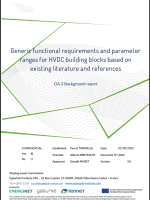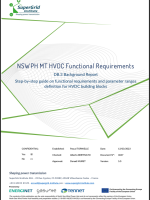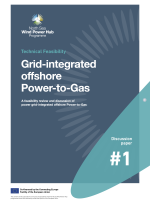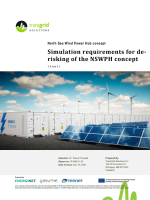Generic functional requirements and parameter ranges for HVDC building blocks
The North Sea Wind Power Hub (NSWPH) consortium is responsible for planning and pre-developing a series of hub-and-spoke projects that will enable large-scale North Sea offshore wind deployment and its integration in the energy system. The hub-and-spoke concept is based on elementary block types used in association to build the distributed hub scenarios. The NSWPH methodology to develop the concept is structured in three phases: pre-feasibility (2020-2021), feasibility (2021-2022) and pre-FEED (2022-2023). The study performed by SuperGrid Institute focuses on the pre-FEED phase and aims to assess from a transmission system operator (TSO) perspective how to derive and specify functional requirements.
The study is divided into two Scopes of Works (SoW). The first, SoW A aims to provide a thorough assessment and to propose typical parameter ranges of functional requirements to be applied for the modular HVDC building blocks based on a review of existing references. In this regard, any shortfalls and gaps of the existing functional requirements that need to be addressed will be identified and studied within SoW B. The second, SoW B focuses on the development of simplistic test benchmarks that are used to define and refine the functional requirements and parameter ranges for HVDC building blocks considering a stepwise increase of complexity of the use cases.
This report summarizes the generic functional requirements and parameter ranges available in existing literature and references. In particular, the CENELEC reports, Part 1: Guidelines and Part 2: Parameter Lists, are considered as the backbone in this assessment. The CENELEC reports describe the requirements in a generic and technology-independent manner and, hence, do not address the project-specific aspects (e.g. integration of offshore wind power parks), nor provide any specific values or typical ranges of parameters. Therefore, the scope of this assessment is primarily given to the requirements relevant to the context of the project under consideration: the innovative hub-and-spoke concept based on the modular elementary blocks of HVDC 2 GW ±525 kV DC bipolar converter station proposed by NSWPH consortium. Each of the identified functional requirements is concisely summarized and complemented by various references (e.g. CIGRE technical brochures, European and national grid codes). Recommendations including the necessary adaptations and the need for further discussions that were identified through the assessment are also summarized. This report is intended to support the descriptions of functional requirements and parameter ranges to be specified in the deliverable “Tendering material for HVDC building blocks for MTDC grids”. A systematic approach has been applied to identify functional requirements and parameter ranges for HVDC building block. For this purpose, four main functional groups have been defined: (i) HVDC system control; (ii) HVDC system protection; (iii) HVDC ancillary services and (iv) HVDC grid operational regimes. A fifth general functional group is also defined to consider HVDC system characteristics. Based on the literature review and considering the focus of the project on the definition of tendering material for the HVDC building blocks, the following functional requirements have been identified to be insufficiently specified in current literature and will be further investigated in SoW B.





